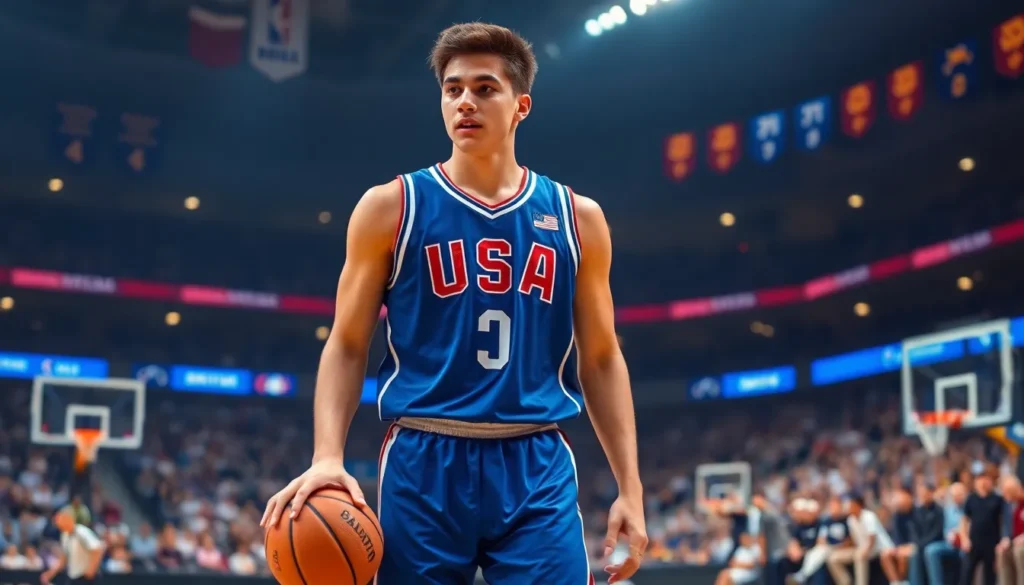Table of Contents
ToggleIn the fast-paced world of the NBA, age is just a number, but it can also be a defining factor in a player’s journey. Fans often marvel at the talent and skill of young athletes who make their mark on the league at an early age. The title of the youngest NBA player sparks curiosity and excitement as it highlights the potential of emerging stars ready to take the court.
As the league evolves, so does the age of its players. With more teenagers entering the draft, the competition becomes fiercer, and the spotlight shines brighter on these young talents. Discovering who holds the record for the youngest player in NBA history reveals not just a statistic but a glimpse into the future of basketball.
Overview of the Youngest NBA Player
The title of the youngest NBA player in history belongs to Andrew Bynum. Bynum debuted on November 2, 2005, for the Los Angeles Lakers at just 18 years and 6 days old. This early entry into the league marked a significant moment, showcasing how talent can emerge at a young age.
The trend of teenagers in the NBA has grown, with several players entering the draft right after high school. For instance, Kobe Bryant and LeBron James joined the league as teenagers, sparking discussions about youth and experience. These young athletes often bring new energy and skills to their teams, impacting game dynamics.
The excitement surrounding young players is palpable, as fans anticipate their development and potential stardom. As youth players adapt to the professional level, their performances can shape future team strategies and league standings. The achievements of the youngest players serve as a benchmark for future prospects, underlining the evolving nature of talent in basketball.
Recent seasons have also seen other young players, such as LaMelo Ball, who debuted at 19 years, highlighting the ongoing shift toward younger talent in the NBA. These developments continue to influence how teams approach drafts and player development, emphasizing the significance of identifying promising young talent early.
Historical Context

Age has played a crucial role in the NBA’s evolution, reflecting broader trends in youth participation and athlete development. Understanding the historical context reveals how player age dynamics have shifted over time.
Evolution of Player Age in the NBA
The NBA’s landscape has transformed significantly regarding player age. In the early years, most players entered the league after completing college. The introduction of the NBA Draft in 1966 allowed teams to select younger talents. By the late 1990s and early 2000s, many athletes bypassed college entirely, entering the draft straight from high school. This change marked a pivotal shift, leading to an influx of players in their late teens.
Notably, the league implemented an age limit in 2005, requiring players to be at least 19 years old before entering the draft. This policy aimed to balance the competition between younger and more experienced players. However, the trend of younger players thriving continued, showcasing their skills and impact on the game.
Notable Young Players Over the Years
Several young players have made a significant impact in the NBA, creating a legacy that underscores the importance of age in the league:
- Andrew Bynum: Holds the record as the youngest player debuting at 18 years and 6 days.
- Kobe Bryant: Entered the NBA at 17, making an immediate impact with the Los Angeles Lakers.
- LeBron James: Debuted at 18 and quickly became a superstar, reshaping the expectations for young players.
- Kevin Garnett: Entered the league at 18, showcasing the potential of high school athletes in professional basketball.
- LaMelo Ball: Debuted at 19, quickly becoming a leader for his team and earning the Rookie of the Year award.
These young athletes not only pushed the boundaries of age but also set benchmarks for future generations. Their successes inspired teams to scout earlier, emphasizing talent assessment and development. The trend continues as younger players increasingly dominate the league, influencing strategies in drafts and player development initiatives.
Current Youngest NBA Player
As of the current NBA season, the youngest player in the league is Victor Wembanyama, who made his debut with the San Antonio Spurs at 19 years and 84 days old. His entry into the league has generated considerable excitement among fans and analysts alike.
Player Profile
Victor Wembanyama stands at 7 feet 2 inches tall and boasts an impressive wingspan of 7 feet 9 inches. Born on January 4, 2004, in Le Chesnay, France, Wembanyama’s unique combination of height, agility, and basketball IQ has positioned him as a top prospect. Prior to joining the Spurs, he played professionally in France, showcasing his ability to score, rebound, and block shots effectively.
Career Highlights and Stats
Wembanyama quickly made an impact in the 2023 NBA season, earning significant recognition for his performance. Key stats from his early games include:
| Statistic | Value |
|---|---|
| Points per game | 15.6 |
| Rebounds per game | 8.2 |
| Blocks per game | 2.4 |
| Assists per game | 3.1 |
These statistics reflect his versatility and potential as a dominant player in the league. As the youngest NBA player, Wembanyama’s career trajectory continues to be closely monitored by teams and fans, anticipating his development into a future superstar.
Significance of Young Players in the NBA
Young players significantly influence the NBA landscape. Their early entry into the league often injects energy and fresh talent into teams, reshaping strategies and dynamics.
Impact on Team Dynamics
Young players bring unique qualities to their teams. They often possess high energy levels and adaptability, which can enhance team performance. Despite inexperience, they challenge established players, fostering a competitive environment that can lead to improved overall performance. For instance, when young talents like LaMelo Ball enter, they frequently disrupt traditional roles, encouraging veterans to elevate their game. Furthermore, the infusion of youthful energy can boost team morale, creating a vibrant locker room atmosphere that propels teams toward success.
Future of Young Talent in the League
The future of young talent in the NBA holds immense potential. Teams increasingly prioritize scouting, identifying players at younger ages and focusing on skill development. This shift reflects a broader trend in professional sports, emphasizing the importance of nurturing talent. With the demographic of younger athletes growing, basketball fans can expect to see an influx of fresh faces making an impact on the game. Additionally, successful young players inspire future generations, creating a cycle of aspirations and achievements, ensuring the league remains dynamic and competitive.
The landscape of the NBA is continually evolving as younger players like Victor Wembanyama step onto the court. Their early entries not only showcase remarkable talent but also ignite excitement among fans and teams alike. The trend of teenagers joining the league has reshaped strategies and dynamics, proving that age isn’t always a barrier to success.
As these young athletes make their mark, they inspire future generations and push the boundaries of what’s possible in basketball. With an increasing focus on scouting and developing talent at younger ages, the future of the NBA looks bright. The influence of youth in the league is undeniable and will continue to shape the game for years to come.




